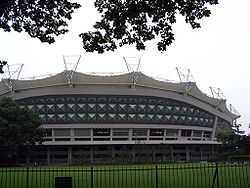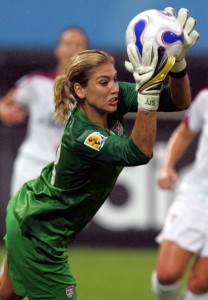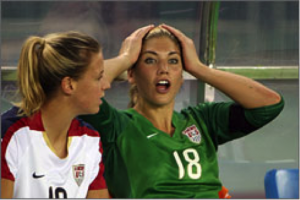Host: China (for the second time)
Dates: September 10- September 30
Winner: Germany
Golden Ball Winner: Marta (Brazil)
Golden Shoe Winner: Marta (Brazil) with 7 goals
The German team celebrating their World Cup victory (Dowling)
Precedents
Since the FIFA Women’s World Cup only originated in 1991, the tournament was still evolving. As such, the 2007 World Cup (fifth Women’s World Cup in history) set new precedents for the tournament. For instance, this is the first Women’s World Cup where all teams were given monetary bonuses according to the last round they reached (2007 FIFA Women’s World Cup). The champions receive $1 million, runners-up receive $800,000, third place receives 650,000, fourth place receives 550,000, quarter-finalists receive 300,000, and first round exits receive 200,000 (2007 FIFA Women’s World Cup). For comparison, monetary bonuses in the FIFA Men’s World Cup range from all participating teams receiving at least $1 million to the champions receiving $30 million.
A second precedent is that this was the first year that the Union of European Football Associations (UEFA) used the FIFA Women’s World Cup as a qualifier for the Olympics, which occurs the year after each World Cup. The top three performing UEFA teams qualify for the Olympics (2007 FIFA Women’s World Cup).
As far as team precedents, Germany beat Argentina by an unprecedented 11-0, the largest score differential in the history of the World Cup. Additionally, Germany did not concede a goal the entire tournament, which is the first time this has happened in the history of the Men’s and Women’s World Cup (FIFA Women’s World Cup China 2007).
Location
China, the host of the first Women’s World Cup back in 1991, was originally slated to host the 2003 World Cup; however, FIFA was forced to move the 2003 tournament to the USA due to a Severe Acute Respiratory Syndrome (SARS) outbreak in China from late 2002 to mid-2003. By the time the 2007 World Cup rolled around, the Chinese Local Organizing Committee was ready to go all out for the tournament (FIFA.com “FIFA Women’s world cup china PR 2007: one year to go). The committee had gained experience after organizing the original World Cup as well as planning for the 2003 World Cup and was working with a larger budget than ever before. After national teams that had participated in the 2003 tournament demonstrated the quality of women’s soccer, FIFA and their commercial partners gave outstanding financial support to fund the 2007 games. Additionally, dozens of companies approached the organizing committee to request broadcasting rights for the tournament (FIFA.com “FIFA Women’s world cup china PR 2007: one year to go).
The tournament was played in five different cities: Wuhan, Shanghai, Hangzhou, Tianjin, and Chengdu. The stadium capacities ranged from 33,000 people in Shanghai’s “Hongkou Stadium” (on right) to 60,000 in Tianjin’s “Tianjin Olympic Centre Stadium. All but the Hongkou Stadium had been built within 10 years of the tournament. Additionally, aside from soccer matches for local Chinese soccer teams, the 2007 World Cup was by far the biggest event these stadiums were used for (Hongkou Football Stadium). There was a total of 1,190,971 viewers throughout the tournament and an average of 37,218 viewers at each game (2007 FIFA Women’s World Cup).
A year of firsts
Two legendary players starred in their national team debut on the 2007 World Cup pitch. One was Hope Solo, who started for the USA as goalkeeper at age 25, replacing veteran goalkeeper Briana Scurry. Additionally, Brazilian forward Marta, 21, began her successful career at the 2007 World Cup. Marta scored 7 goals in the tournament, earning both the Golden Shoe and Golden Ball awards in her World Cup debut. 
 Left: U.S. goal keeper Hope Solo makes a save in their win against Sweden in the group stage of the 2007 World Cup (Martinez)
Left: U.S. goal keeper Hope Solo makes a save in their win against Sweden in the group stage of the 2007 World Cup (Martinez)
Right: Marta holds the Golden Ball and Shoe awards she received at the 2007 World Cup (redjiblog)
Controversy
Hope Solo had started in every match of the group stage as well as the first match against England in the knockout stage for the 2007 World Cup. However, head coach Greg Ryan opted to play veteran goalkeeper Briana Scurry over Solo in their semifinals game against Brazil. Ryan made this decision based on Scurry’s previous success against Brazil; she had played Brazil’s national team 12 times and won each game (“Goalie switch fails to work as USA falls to Brazil – USATODAY.com”). However Scurry had never faced 21-year-old Marta, who ended up winning the Golden Ball and Golden Shoe of the tournament. With Scurry in the goal, the U.S. lost 0-4, their worst loss in the Women’s National Team history, and ended the team’s 51-game winning streak (“Goalie switch fails to work as USA falls to Brazil – USATODAY.com”). In response to being benched, Solo said, “there’s no doubt in my mind I would have made those saves. And the fact of the matter is, it’s not 2004 anymore,” (Nye) referencing Scurry’s last major victory when the WNT won the 2004 Olympic games in Athens. Solo was suspended from the team; however, was returned to the team as starting goalkeeper just one year later in the 2008 Olympics (Nye).
and won each game (“Goalie switch fails to work as USA falls to Brazil – USATODAY.com”). However Scurry had never faced 21-year-old Marta, who ended up winning the Golden Ball and Golden Shoe of the tournament. With Scurry in the goal, the U.S. lost 0-4, their worst loss in the Women’s National Team history, and ended the team’s 51-game winning streak (“Goalie switch fails to work as USA falls to Brazil – USATODAY.com”). In response to being benched, Solo said, “there’s no doubt in my mind I would have made those saves. And the fact of the matter is, it’s not 2004 anymore,” (Nye) referencing Scurry’s last major victory when the WNT won the 2004 Olympic games in Athens. Solo was suspended from the team; however, was returned to the team as starting goalkeeper just one year later in the 2008 Olympics (Nye).
Affect on the 2008 Olympics
2007 was the first year that the FIFA Women’s World Cup was used as a qualifier for the Olympics. The top three European finishers qualify, which in 2007 were Germany, Brazil, and England. However since England competes as Great Britain (rather than England) in the Olympics, England was not given the third qualifying spot. Instead the next two top European teams, Sweden and Denmark, competed in a UEFA playoff game and the winner, Sweden, advanced to the 2008 Olympic games (Football at the 2008 Olympics– Women’s Tournament).
The result of the Women’s soccer tournament in the Olympics varied only slightly from the FIFA World Cup. The top three teams were the same in both tournaments; however, the USA finished first, Brazil second, and Germany third in the Olympics just one year later. This could be due in part to the U.S. opting to start Hope Solo in goal rather than older veteran goalkeeper Briana Scurry as they had done in the World Cup (Football at the 2008 Olympics– Women’s Tournament).
Group Stage
Group A: Germany, England, Japan, and Argentina
Germany, the number one seed in the tournament, annihilated the competition, winning their two games against Argentina (11-0) and Japan (2-0) and tying England after a scoreless match. As expected, Germany easily advanced to the knockout round. England was the other team to advance from group A, beating Argentina 6-1 and ending up with a second draw against Japan (2-2). Argentina, the lowest ranked team in the group, lost all three of their games, including a 1-0 loss against Japan (2007 FIFA Women’s World Cup).
https://youtu.be/3l4G4tXKxwo?t=20s
Women’s World Cup 2007 Germany 11-0 Argentina highlight
Group B: USA, North Korea, Sweden, and Nigeria
Group B was an exact repeat of group A in the 2003 World Cup, but yielded a slightly different outcome. The group stage results of these four teams were very cut and dry in the previous World Cup, with USA winning all three games, Sweden winning two, North Korea winning one, and Nigeria losing all three. However the 2007 results involved some upsets. Rather than Sweden advancing to the knockout round, North Korea advanced alongside the USA. USA won their games against Sweden (2-0) and Nigeria (1-0) and tied North Korea 2-2. These games were much closer than the previous World Cup, where the USA had defeated Nigeria 5-0 (2007 FIFA Women’s World Cup).
 North Korean defender Sonu Kyong Sun heads the ball away from Sweden’s Sara Johansson as she takes a shot on goal during the Sweden vs North Korea game in the group stage (Baker).
North Korean defender Sonu Kyong Sun heads the ball away from Sweden’s Sara Johansson as she takes a shot on goal during the Sweden vs North Korea game in the group stage (Baker).
Group C: Norway, Australia, Canada, and Ghana
Norway finished at the top of group C, after crushing Ghana (7-2), defeating Canada by one (2-1), and tying Australia 1-1. Australia finished in second place with a 4-1 win over Ghana and a tie against Canada (2-2). Ghana finished last after losing all three of their games, including a 4-0 loss to Canada. These results were very predictable; Ghana was by far the lowest ranked team going into the 2007 World Cup, with a ranking of 47th in the world (The FIFA Women’s World Ranking)
Group D: Brazil, China PR, Denmark, New Zealand
Brazil dominated Group D and advanced to the knockout stage without conceding a single goal. The Brazilians beat New Zealand 5-0, China PR 4-0, and Denmark 1-0. China also advanced to the knockout stage by beating Denmark 3-2 and New Zealand 2-0. Denmark finished third in the group after they beat New Zealand 2-0. New Zealand went scoreless for the entire competition. In the photo on the right, defender Abby Erceg (left) defends the ball from striker Marta in the Brazil vs. New Zealand game in the group stage (Niu)
Knockout Stage
Quarterfinals
Germany continued their domination with a 3-0 win against North Korea, Norway defeated China Pr 1-0, and the U.S. defeated England 3-0. The only match where the losing team managed to score a goal was Brazil vs Australia, where Brazil beat the Aussies 3-2. Ironically, Brazil had been one of two teams (the other team being Germany) to not concede a goal during the group stage.
Semifinals
In a series of uneventful matches where the losing team couldn’t even score a single goal, Germany defeated Norway 3-0 and Brazil beat the U.S. 4-0. These results were surprising, considering that in June 2007 (the most recent FIFA Women’s Rankings before the tournament) the USA was ranked 1st, Germany 2nd, Norway 4th, and Brazil 8th in the world (The FIFA Women’s World Ranking). However taken in the context of the games, these decisive wins were expected. Not a single goal was scored on Germany throughout the entire World Cup, due to the exceptional German Goalkeeper and “Best Goalkeeper Award” recipient for the tournament Nadine Angerer. Additionally, the rankings did not fully account for Brazilian striker Marta, who made her national debut on the Brazilian team at this tournament. Additionally, starting U.S. goalkeeper Hope Solo was benched for the Brazil vs USA game, which greatly hurt the team in retrospect. In the third place match, the U.S. defeated Norway 4-1.
Brazil Marta Amazing Goal vs USA (World Cup China)
Final
In an entertaining match, Germany defeated Brazil 2-0 to earn their second World Cup championship title. The match was scoreless until Germany scored their first goal just over halfway through the game. Brazil received a penalty kick near the 65-minute mark, but Germany’s goalkeeper Nadine Angerer deflected Marta’s shot. After that, Germany’s goal very late in the game cemented their victory. Germany’s success was due to a combination of top-notch goalkeeping by Angerer, as well as the German defense successfully keeping the ball away from the tournament’s top scorer: Marta. This was the first ever Women’s World Cup to be between a European and South American team, as well as the first time a South American team competed in the Final.
https://youtu.be/qUaaz6WgHq4
Final: Germany 2 Brazil 0- 2007 FIFA Women’s World Cup
Looking Ahead
Group B for the 2007 tournament was almost exactly the same as the 2015 tournament this summer, except Australia will be replacing North Korea (Verschueren). While many are calling the USA’s bracket the “group of death,” the USA finished at the top of the group back in 2007, and could definitely do so again. Although these teams have all changed since 2007, there’s a good chance that the results of the games this summer will be similar to past results. This group in 2007 was an exact repeat of a group in the 2003 tournament and the results were very similar.
Return to History of the Women’s World Cup Main Page.
Sources
Baker, Greg. “FIFA Women’s World Cup — China 2007 – Photo Essays.” Time. Time Inc. Web. 27 Apr. 2015. <http://content.time.com/time/photogallery/0,29307,1666987_1455241,00.html>.
Dowling, Siobhan. “Women’s Football Is Still a Pauper’s Game, despite World Cup Success.” Theguardian. Guardian News and Media Limited, 15 July 2011. Web. 26 Apr. 2015. <http://www.theguardian.com/football/2011/jul/15/womens-football-paupers-game-despite-world-cup-success>.
“FIFA Women’s World Cup China 2007.” FIFA.com. FIFA. Web. 26 Apr. 2015. <http://www.fifa.com/tournaments/archive/womensworldcup/china2007/index.html>.
“FIFA Women’s World Cup China PR 2007: One Year to Go.” FIFA.com. FIFA, 10 Sept. 2006. Web. 26 Apr. 2015.<http://www.fifa.com/tournaments/archive/womensworldcup/china2007/news/newsid=106069/index.html>.
“Football at the 2008 Olympics– Women’s Tournament.” Wikipedia. Wikipedia, 9 Jan. 2015. Web. 26 Apr. 2015. <http://en.wikipedia.org/wiki/Football_at_the_2008_Summer_Olympics_–_Women’s_tournament#Qualifying>.
“Goalie Switch Fails to Work as USA Falls to Brazil – USATODAY.com.” Goalie Switch Fails to Work as USA Falls to Brazil – USATODAY.com. USA TODAY, 1 Jan. 2007. Web. 26 Apr. 2015. <http://usatoday30.usatoday.com/sports/soccer/worldcup/2007-09-27-usa-brazil-semi_N.htm>.
“Hongkou Football Stadium.” Wikipedia. Wikimedia Foundation, 30 Nov. 2014. Web. 26 Apr. 2015. <http://en.wikipedia.org/wiki/Hongkou_Football_Stadium>.
Martinez, Ronald. “Hope Photostream.” Zimbio. 11 Sept. 2007. Web. 26 Apr. 2015. <http://www.zimbio.com/photos/Hope Solo/Group B USA v Korea PDR Women World Cup 2007/4kpD98muGXi>.
Niu, Guang. “Abby Erceg of New Zealand and Marta of Brazil Fight for the Ball…” Getty Images. Getty Images. Web. 29 Apr. 2015. <http://www.gettyimages.com/detail/news-photo/abby-erceg-of-new-zealand-and-marta-of-brazil-fight-for-the-news-photo/76683754>.
Nye, James. “Hope Solo Reveals How She Was Kicked off U.S. Team in 2007 after Being Accused of ‘treason'” Mail Online. Associated Newspapers, 14 Aug. 2012. Web. 26 Apr. 2015. <http://www.dailymail.co.uk/news/article-2188214/Hope-Solo-reveals-kicked-U-S-team-2007-accused-treason.html>.
Redjiblog. “Can Marta Lead Brazil to World Cup Glory?” Lako A Football Aficionados Blog. 1 July 2011. Web. 26 Apr. 2015. <https://redjiblog.wordpress.com/2011/07/01/can-marta-lead-brazil-to-world-cup-glory/>.
“The FIFA Women’s World Ranking – FIFA.com.” FIFA.com. FIFA. Web. 27 Apr. 2015. <http://www.fifa.com/fifa-world-ranking/ranking-table/women/rank=518/index.html>.
Turner, Georgina. “The Joy of Six: Women’s Football.” Theguardian. Guardian News and Media Limited, 24 June 2011. Web. 26 Apr. 2015. <http://www.theguardian.com/sport/blog/2011/jun/24/joy-of-six-womens-football>.
Verschueren, Gianni. “USA Draw Group of Death in World Cup.” Bleacher Report. 6 Dec. 2014. Web. 26 Apr. 2015. <http://bleacherreport.com/articles/2291332-2015-womens-world-cup-draw-results-groups-schedule-and-bracket-info>.
“2007 FIFA Women’s World Cup.” Wikipedia. Wikimedia Foundation, 6 Mar. 2015. Web. 26 Apr. 2015. <http://en.wikipedia.org/wiki/2007_FIFA_Women’s_World_Cup#Other_rewards>.


In response to the controversy section, I definitely think that Hope Solo’s behavior was unsportsmanlike. Cockiness and overconfidence get you nowhere. Even if she thought she was right in saying so, for her to say it right after their loss only add insult to injury. She may have been right, but at the end of the day, she has to respect her coach’s decision. Briana Scurry had already proven herself against Brazil and thus has earned her position on that game. I don’t know that Solo’s suspension was long enough but if her behavior improved, even a little bit, I don’t see why the team should not have allowed her back in order to put their best foot forward at the Olympics.